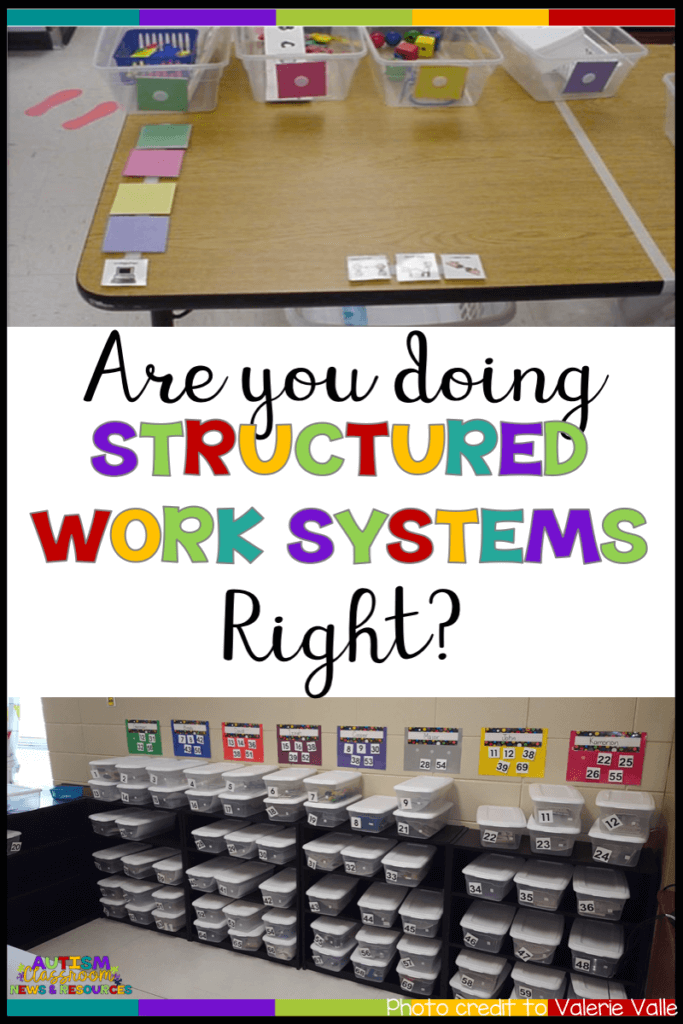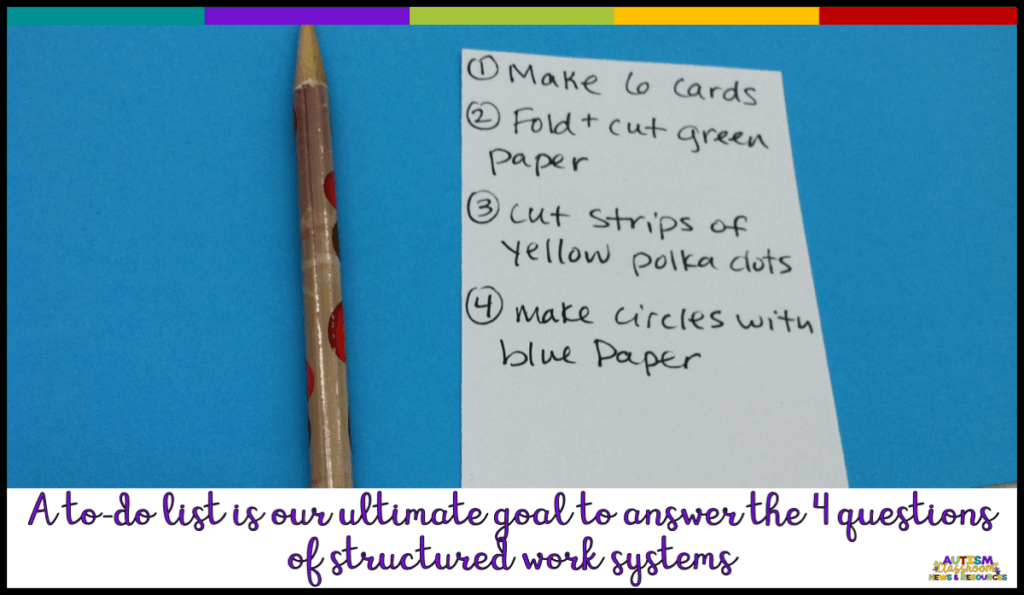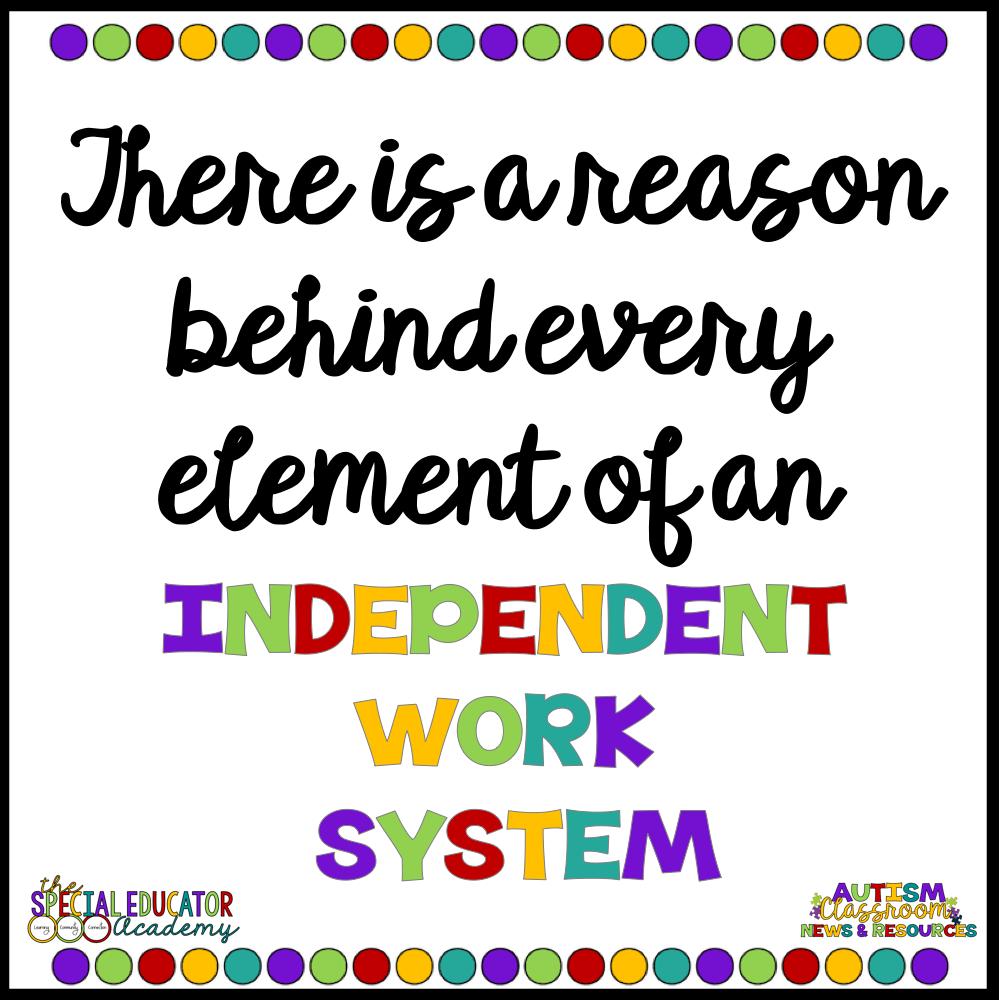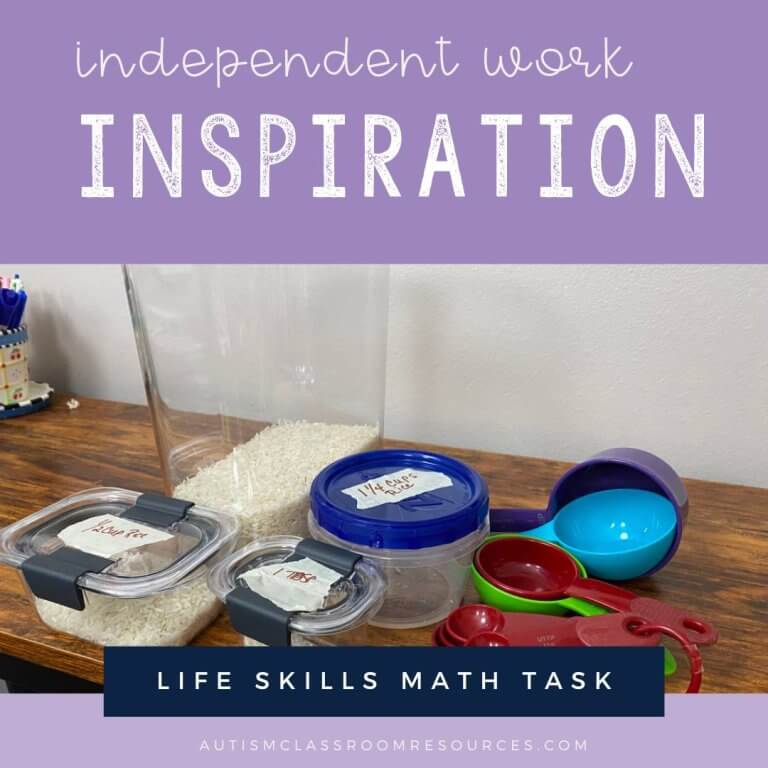Sharing is caring!


So, we’ve talked about how independent work systems can help the student, in the classroom, at home, and on the job. Now it’s time to get to the meat of what they should look like.
Structured work systems began as part of Structured Teaching from TEACCH at UNC Chapel Hill. And the components of them have begun to be researched more thoroughly in the last few years.
In order to be effective as an emerging evidence-based practice, though, we have to make sure they are implemented as intended. And that we are consistent with the research in our use of them. That starts with recognizing the fundamental elements of the system.
4 Questions Every Structured Work System Answers
Every structured work system should answer all of the 4 questions below. These are good questions to ask about the physical environment and use of visuals as well. However, they specifically address how we set up our work systems. If you find that your work systems aren’t answering one of these questions, you may want to go back and make some changes.
1. What work needs to be done?
Work systems tell our students what work they are expected to complete. This eases uncertainty in knowing what people expect of them. It also assures that they know when they have finished a task.
This element of the system is typically addressed through the use of some type of schedule. Some students may start out with just a set of baskets in front of them that they are expected to complete from left to right. But students should pretty quickly move to a system that uses a schedule to tell them what to do.
Why do we need a schedule if they can see the work? Because it’s the only way to expand the system beyond those 3 baskets sitting in front of them. Wouldn’t you like the student to be able to get his own work off a list, complete it and put it away? I would…that’s why we were teaching him to be independent. However if he only knows to complete the work in front of him, he can’t make that shift. That means you have to keep setting up his work for him–not very independent.
The schedule can be matching cards or a to-do list. As long as the student can understand it, it’s fine. But to leave out the schedule means that we aren’t clearly giving information about how much work the student has to do-at least not in a way that maintains for the long term. The schedule answers how many jobs need to be done.
Why do we need a schedule if they can see the work? Because it's the only way to expand the system . Click to Tweet2. How much work need to be done?
Knowing how much work needs to be done within the job is an important element as well. Ever had a student who becomes completely overwhelmed when you show him a task? Or a student who is paralyzed with overwhelm because he can’t see the end of the task? Have you ever felt that way yourself? I have. It’s a feeling that you can’t see the end so it feels overwhelming to start.
That’s what answering this question does for the student. If you are using a traditional basket system, he can see how much work is in the basket. But eventually we might put how much he needs to do on his to list (e.g., make 6 cards). That way he knows when he starts what the expectations are.

3. How Do I Know When I’m Finished?
This element is critical and probably the one I see most people ignore. I can’t tell you how many times I walk into classrooms, having set up work systems, only to find the finished basket missing. Why is it missing? Because the teacher thought it was just a thing for storage.
The finished basket (or shelf, or folder, or envelope) is critical because it answers this question. It’s also why it’s important to make sure that we don’t have extra pieces in the bins to confuse the student. You know that feeling you get when you put together a piece of furniture that needed assembly. Except at the end you have a bunch of extra pieces? Yea, that’s how your students feel when you put more file folder pieces in the box than fit in the file folder. Or when they are collating a task and they have extras of some pages and not others. They can’t finish the job when there are extras and they don’t know when they are finished.
Aligned with this question is also the need for the student to put the work away completed. As I mentioned in the last post, you don’t want the student to fill up the salt shakers and then empty them. That’s not how we do a job. If we are preparing them to work independently, it’s critical that they know when the job is completed.

4. What Do I Do Next?
This is another element that’s easy to leave off. It’s easy to think that the students should be internally motivated or know what to do next. However, if they did, they probably would not need an independent work system.
What’s next can consist of several elements including a reinforcer and instructions for where to go or what to do. It’s traditionally put at the end of the schedule. It might be a picture or just an item on the list. For instance, it might include:
- Reinforcer for work completion
- Instructions to tell the teacher he is finished
- A cue to ask someone to check his work
- Information about where to go
So, regardless of whether your work system is a basket system, a folder system, an inbox system or just a to-do list, you want to make sure it answers these four questions.
Does your system answer them? What element might be missing?





![Independent Work-3 Ways It can Become Your Best Classroom Management Tool [A sorting task in a shoebox to sort nouns from verbs on popsicle sticks into plastic cups]](https://autismclassroomresources.com/wp-content/uploads/2023/06/BLOG-22208-3-Ways-Task-Boxes-and-IW-Help-Classroom-Management-2-768x644.jpg)
